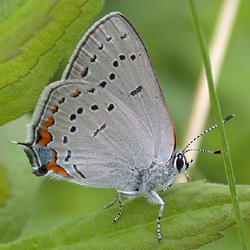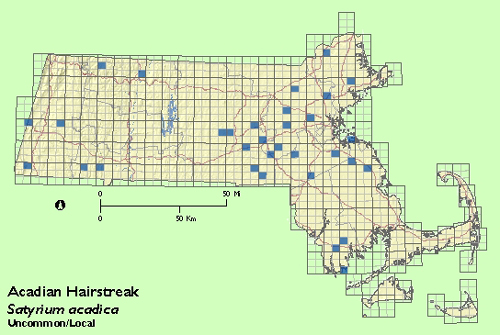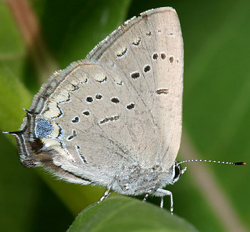Find a Butterfly
Acadian Hairstreak
Satyrium acadica
Named
W. H. Edwards, 1862

Identification
Wingspan: 1-1 1/4". The orange "cap" on the blue spot in the lower corner of the hind wing below gives further confirmation. The submarginal row of white-ringed black dots on both fore and hindwings below is diagnostic among northeastern hairstreaks. Another clue to this species identity is its association with willow bordered wetland habitats.
Distribution
Southeastern British Columbia and Washington east to Nova Scotia and south to New Jersey. Throughout New England excepting northern Maine.
Status in Massachusetts
Uncommon and notably local. Most Atlas records occur in eastern Massachusetts, but a scattering of records was also obtainedin the western part of the state; it was very common on the 1992 Berkshire 4th of July count. Other than records from the western side of Buzzards Bay, including at least one sizable colony (see "Maximum" below), Acadian Hairstreak was not found in large portions of central and southeastern Massachusetts. While Scudder (1889) collected this species on Cape Cod, it was not found there or on the adjacent coastal islands by Atlas workers. Maximum: 40, New Bedford (Bristol Co.).

Flight Period in Massachusetts
Single flight: July; the majority of records from the first three weeks of the month. Extreme dates: 22 June 1991 BMBS (Worcester Co.), T. Dodd; 12 August 1992, Easton (Bristol Co.), L. Lovell.
Larval Food Plants
Willows including Black Willow (Salix nigra) and Pussy Willow (S. discolor).
Adult Food sources
Perhaps most commonly nectars at milkweeds and Meadowsweet (9 species during Atlas period).

Habitat
Wetland edges and associated fields.
Life Cycle
EGG: White with greenish or rose hue; turban shaped with numerous spurs and a large depression at top. OVIPOSITION: Eggs laid on the woody parts of willows. LARVA: Brown headed with grass green body and pale yellowish green side stripes. CHRYSALIS: Yellowish brown above with numerous brown spots; brown below with various dark bands. OVERWINTERING STAGE: egg.
In early July adults emerge from the pupal state and are found along wetland edges with associated willows as well as in nearby meadows nectaring on a variety of blossoms. Scott (1986) mentions that the caterpillars are associated with ants but no details are given.
Account Author
Richard K. Walton
Additional Information
Read more on this species at the North American Butterfly Association.



